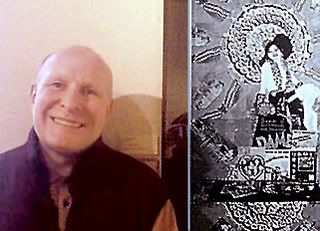Sitemeter Sez: Moscow, Moscow City; Екатерина помогает чемпионом через желоба... Inset: Susie Scott, Playboy 's Miss May of 1983. Врезка: Сьюзи Скотт, "Плейбой" с "Мисс май 1983 года. She put the Salt Lake City Track Club on the national map when she wore one of our t-shirts in her article -- she ran in our winter 50K series... Somewhere in the United Kingdom; Durham, North Carolina and Smithtown, New York.
ROCK against Reaganomics at: Theater X-Net

Starring: Ida Rubinstein Belle Epoch Russian/Parisian beauty.
Ida's Places in Paris -- from my first jet-lagged day by the Seine.
Read more about Ida in Sisters of Salome by Toni Bentley

Visit: Michael's Montana Web Archive
Theater, Art, Flash Gordon, Funky Music and MORE!
NEW --Launching NOW! Outre Space Cinema -- Featuring: 1930's Rocketry, Spitfires of the Spaceways and Cellulose to Celluloid, Flash Gordon in the Saturday Matinees and Sunday Comics -- UPDATED!

Thanks to Jim Keefe (Visit his Website) -- the LAST Flash Gordon illustrator of the 20th Century, and Flash's first illustrator of the 21st, for his recommendations -- HERE!
Charity Alert: Keep that Resolution to click on The Hunger Site every day. Also check into Terra Sigilata blog -- donate $$$ to cancer patients just by clicking onto the site.
In The Community: All students are admitted FREE this year to the Hockaday Museum of Art, thanks to Pacific Steel & Recycling. I'm STILL adding images to the Auction of Miniatures page.
Check out Fall for Glacier too -- a fundraiser for several programs that make Glacier National Park even better!
Media Watch: The 80th Academy Awards -- Marion Cotillard did a good job of acting in that morbid flick En Vie La Rose, and now she's won the Oscar and Golden Globe for her work this year.
Real Books: I'm still strolling through the pages of J.R.R. Tolkien's Lord of the Rings. I was once able to read each volume in six hours -- kind of like watching a movie with my mind's eye. The experience is different now. Age alone is bound to alter my perspective as the long story unfolds before bedtime.
Tolkien first won me over with the force of his personality, expressed right on the cover of the Ballantine paperback:
...this paperback edition and no other has been published with my consent and co-operation. Those who approve of courtesy (at least) to living authors will purchase it an no other.
I had anticipated buying the book since seeing the Ace paperbacks, but there was something about his direct appeal that convinced me to take it off the shelf of Sam Weller's Books and buy it then and there, even though the other edition was available for five cents less, right around the corner.
Tolkien's forward and map cemented the foundation of the enduring bond I have since enjoyed with his magical sub-world:
...The most critical reader of all, myself, now finds many defects, minor and major, but being fortunately under no obligation either to review the book or to write it again, he will pass over these in silence, except one that has been noted by others; the book is too short.
British modesty, with a bold-as-brass assertion that he could have said more!
Since I'm writing a de facto essay about Tolkien's forward, I'll make sure I sketch out his description of the Rings' progress:
1936 -- First drafts of The Hobbit's sequel, between the writing of The Hobbit, and it's publication in 1937. (The Shadow of the Past and more writings.)
1939 -- Book I (The Black Riders) is not quite complete at the end of the year.
1940 -- Balin's Tomb and a long halt.
1941 -- Lothlorien and the Great River.
1942 -- First drafts of Book III (Riders of Rohan) and start of Book V (Gondor).
1944 -- Book IV (Dead Marshes and Mordor) sent as a serial to son Christopher in the RAF in South Africa.
1945 to 1949 -- Then when the 'end' had at last been reached the whole thing had to be revised, and indeed largely rewritten backwards.
Other reading reveals constant proddings by Tolkien's fellow Inklings, a group of Oxford men led by C. S. Lewis, who also included Christopher among their number after WWII. Humphrey Carpenter's collection of Tolkien's letters showed financial pressures on the Professor as he forsaw the end of his scholastic career while the trilogy was slowly being published in severely austere postwar Britain.
The eventual success of Lord of the Rings revolutionized Fantasy as a literary genre, and created a persistant demand for everything he ever wrote. Christopher R. Tolkien, as literary executor, edited and published his father's copious drafts and notes in a series of books called The History of Middle Earth. I collected almost all of the 13 volumes, and had fun seeing how Tolkien's imaginary sub-world took shape. One observation I can share from all that stuff was that he wasn't kidding about rewriting the book backwards from its original end!

Barbara Remington's evocative covers for Ballantine's Lord of the Rings in poster form circa 1968. The Ringwraiths or Black Riders (center) were such archetypical boogiemen that I still find it fun to ruminate about them. Scary as they were, Tolkien set strongly-implied limits on their powers, at least early-on in the book, otherwise those big fast guys would have had no problems seizing the Great Ring from the small slow-moving Hobbits. Later the 'Nazgul' were so powerful they risked undercutting the "willing suspension of disbelief" which Tolkien so aptly identified in readers who enjoyed literary creations like Middle Earth. I highly recommend his essay On Fairy Stories, where he outlines his aesthetics of this form.

No comments:
Post a Comment